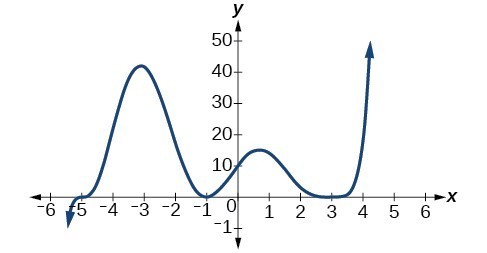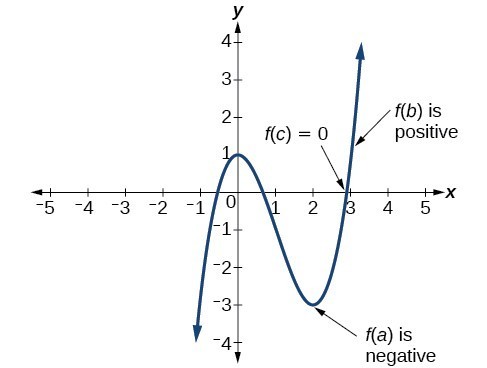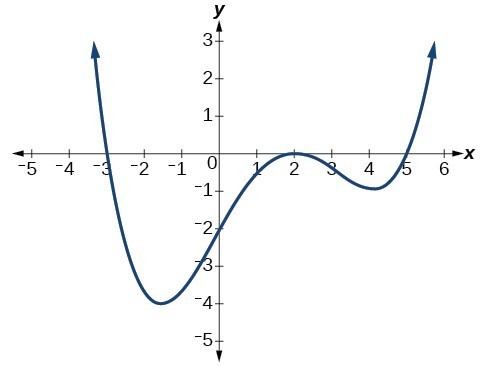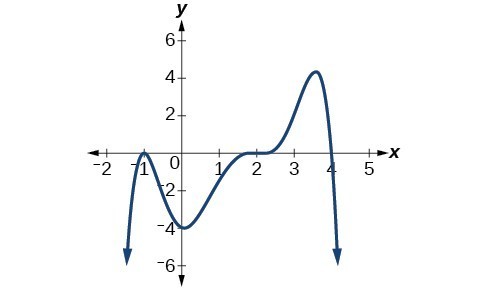Graphing Polynomials In Standard Form
Learning Outcomes
- Identify zeros of polynomial functions with even and odd multiplicity.
- Describe the graph of a polynomial function using end beliefs, turning points, intercepts, and the Intermediate Value Theorem.
- Write the equation of a polynomial function given its graph.
The revenue in millions of dollars for a fictional cable company from 2006 through 2013 is shown in the table below.
| Yr | 2006 | 2007 | 2008 | 2009 | 2010 | 2011 | 2012 | 2013 |
| Revenue | 52.4 | 52.8 | 51.two | 49.5 | 48.6 | 48.half dozen | 48.7 | 47.ane |
The revenue can be modeled past the polynomial function
[latex]R\left(t\right)=-0.037{t}^{4}+1.414{t}^{3}-xix.777{t}^{ii}+118.696t - 205.332[/latex]
where R represents the revenue in millions of dollars and t represents the year, with t = six corresponding to 2006. Over which intervals is the acquirement for the company increasing? Over which intervals is the revenue for the company decreasing? These questions, along with many others, can be answered by examining the graph of the polynomial function. We have already explored the local behavior of quadratics, a special case of polynomials. In this section nosotros will explore the local behavior of polynomials in general.
Multiplicity and Turning Points
Graphs behave differently at various x-intercepts. Sometimes the graph will cross over the x-axis at an intercept. Other times the graph will touch the ten-axis and bounce off.
Suppose, for case, we graph the function [latex]f\left(x\right)=\left(x+iii\correct){\left(x - 2\correct)}^{2}{\left(10+1\right)}^{3}[/latex].
Notice in the figure below that the behavior of the function at each of the x-intercepts is unlike.

The behavior of a graph at an 10-intercept can be determined by examining the multiplicity of the naught.
The x-intercept [latex]x=-3[/latex] is the solution to the equation [latex]\left(x+three\right)=0[/latex]. The graph passes straight through the x-intercept at [latex]10=-3[/latex]. The factor is linear (has a degree of one), and then the behavior near the intercept is like that of a line; it passes directly through the intercept. We phone call this a unmarried null because the zilch corresponds to a unmarried cistron of the function.
The x-intercept [latex]x=2[/latex] is the repeated solution to the equation [latex]{\left(x - 2\right)}^{2}=0[/latex]. The graph touches the axis at the intercept and changes direction. The factor is quadratic (degree 2), so the behavior near the intercept is like that of a quadratic—it bounces off of the horizontal axis at the intercept.
[latex]{\left(x - 2\right)}^{2}=\left(x - two\right)\left(x - two\right)[/latex]
The gene is repeated, that is, the factor [latex]\left(x - 2\right)[/latex] appears twice. The number of times a given factor appears in the factored form of the equation of a polynomial is called the multiplicity. The zero associated with this gene, [latex]x=2[/latex], has multiplicity ii because the factor [latex]\left(ten - 2\right)[/latex] occurs twice.
The x-intercept [latex]x=-1[/latex] is the repeated solution of cistron [latex]{\left(x+1\right)}^{3}=0[/latex]. The graph passes through the axis at the intercept but flattens out a bit first. This factor is cubic (degree 3), and so the behavior nearly the intercept is similar that of a cubic with the same S-shape near the intercept as the office [latex]f\left(x\correct)={x}^{3}[/latex]. We call this a triple zero, or a cipher with multiplicity 3.
For zeros with even multiplicities, the graphstouch or are tangent to the x-axis at these 10-values. For zeros with odd multiplicities, the graphs cantankerous or intersect the x-axis at these 10-values. Run across the graphs below for examples of graphs of polynomial functions with multiplicity i, 2, and 3.

For higher even powers, such as iv, 6, and 8, the graph volition notwithstanding touch and bounce off of the x-axis, but for each increasing even power the graph will appear flatter as information technology approaches and leaves the x-axis.
For higher odd powers, such as 5, 7, and 9, the graph will nonetheless cross through the 10-axis, only for each increasing odd ability, the graph will appear flatter every bit information technology approaches and leaves the x-axis.
A General Notation: Graphical Behavior of Polynomials at x-Intercepts
If a polynomial contains a factor of the course [latex]{\left(10-h\right)}^{p}[/latex], the behavior near the 10-intercept his determined past the ability p. Nosotros say that [latex]10=h[/latex] is a nada of multiplicity p.
The graph of a polynomial office volition touch the x-axis at zeros with even multiplicities. The graph will cross the 10-centrality at zeros with odd multiplicities.
The sum of the multiplicities is the degree of the polynomial function.
How To: Given a graph of a polynomial function of degree [latex]north[/latex], identify the zeros and their multiplicities.
- If the graph crosses the x-axis and appears almost linear at the intercept, it is a single zilch.
- If the graph touches the x-axis and bounces off of the centrality, it is a zero with even multiplicity.
- If the graph crosses the 10-centrality at a zero, it is a zero with odd multiplicity.
- The sum of the multiplicities is the degreenorth.
Instance: Identifying Zeros and Their Multiplicities
Use the graph of the function of caste vi to place the zeros of the role and their possible multiplicities.

Try It
Use the graph of the part of degree 7 to identify the zeros of the function and their multiplicities.

Prove Solution
The graph has a nothing of –5 with multiplicity 3, a zip of –i with multiplicity 2, and a null of iii with multiplicity 2.
Determining End Behavior
As we take already learned, the behavior of a graph of a polynomial function of the form
[latex]f\left(x\correct)={a}_{n}{x}^{n}+{a}_{northward - 1}{10}^{due north - ane}+…+{a}_{1}10+{a}_{0}[/latex]
volition either ultimately rise or fall as 10 increases without bound and volition either rise or fall as xdecreases without bound. This is considering for very large inputs, say 100 or 1,000, the leading term dominates the size of the output. The same is true for very small inputs, say –100 or –i,000.
Recollect that we call this behavior the end behavior of a role. Every bit we pointed out when discussing quadratic equations, when the leading term of a polynomial function, [latex]{a}_{n}{x}^{n}[/latex], is an fifty-fifty power function, equally x increases or decreases without jump, [latex]f\left(x\right)[/latex] increases without bound. When the leading term is an odd ability function, equallyx decreases without jump, [latex]f\left(x\right)[/latex] also decreases without bound; equally x increases without bound, [latex]f\left(x\correct)[/latex] also increases without spring. If the leading term is negative, it will change the direction of the cease behavior. The table beneath summarizes all four cases.
| Even Degree | Odd Degree |
|---|---|
 |  |
 |  |
Try Information technology
Graphing Polynomial Functions
We can use what we have learned about multiplicities, terminate behavior, and turning points to sketch graphs of polynomial functions. Let united states of america put this all together and look at the steps required to graph polynomial functions.
How To: Given a polynomial part, sketch the graph
- Find the intercepts.
- Check for symmetry. If the function is an even role, its graph is symmetric with respect to they-centrality, that is,f(–10) = f(x).
If a office is an odd function, its graph is symmetric with respect to the origin, that is,f(–x) = – f(x). - Apply the multiplicities of the zeros to make up one's mind the behavior of the polynomial at the 10-intercepts.
- Determine the end behavior by examining the leading term.
- Use the end behavior and the behavior at the intercepts to sketch the graph.
- Ensure that the number of turning points does non exceed one less than the degree of the polynomial.
- Optionally, utilise applied science to bank check the graph.
Example: Sketching the Graph of a Polynomial Function
Sketch a possible graph for [latex]f\left(x\right)=-2{\left(ten+3\correct)}^{2}\left(x - five\right)[/latex].
Endeavor It
Sketch a possible graph for [latex]f\left(x\right)=\frac{i}{four}x{\left(10 - one\right)}^{4}{\left(10+iii\right)}^{three}[/latex].
The Intermediate Value Theorem
In some situations, we may know two points on a graph but not the zeros. If those ii points are on opposite sides of the x-centrality, we tin can confirm that there is a zero betwixt them. Consider a polynomial function f whose graph is smooth and continuous. The Intermediate Value Theorem states that for two numbers a and b in the domain of f, if a< b and [latex]f\left(a\right)\ne f\left(b\right)[/latex], then the function f takes on every value between [latex]f\left(a\correct)[/latex] and [latex]f\left(b\right)[/latex].
We can apply this theorem to a special example that is useful for graphing polynomial functions. If a bespeak on the graph of a continuous function f at [latex]x=a[/latex] lies to a higher place the 10-axis and another signal at [latex]x=b[/latex] lies beneath the ten-axis, there must exist a third point between [latex]10=a[/latex] and [latex]x=b[/latex] where the graph crosses the x-centrality. Call this point [latex]\left(c,\text{ }f\left(c\right)\right)[/latex]. This ways that nosotros are assured in that location is a valuec where [latex]f\left(c\right)=0[/latex].
In other words, the Intermediate Value Theorem tells u.s. that when a polynomial part changes from a negative value to a positive value, the function must cantankerous the x-axis. The effigy below shows that there is a goose egg between a and b.

The Intermediate Value Theorem can be used to show there exists a nix.
A General Note: Intermediate Value Theorem
Allow f exist a polynomial function. The Intermediate Value Theorem states that if [latex]f\left(a\correct)[/latex] and [latex]f\left(b\right)[/latex] accept opposite signs, then there exists at least one value c between a and b for which [latex]f\left(c\right)=0[/latex].
Example: Using the Intermediate Value Theorem
Testify that the function [latex]f\left(x\right)={x}^{3}-v{x}^{2}+3x+6[/latex] has at to the lowest degree two real zeros betwixt [latex]x=1[/latex] and [latex]10=4[/latex].
Try It
Show that the role [latex]f\left(x\right)=vii{x}^{v}-ix{x}^{iv}-{x}^{2}[/latex] has at least i real zero between [latex]x=1[/latex] and [latex]ten=2[/latex].
Show Solution
Because f is a polynomial part and since [latex]f\left(one\right)[/latex] is negative and [latex]f\left(2\right)[/latex] is positive, there is at least i real zero betwixt [latex]x=1[/latex] and [latex]10=two[/latex].
Writing Formulas for Polynomial Functions
At present that we know how to find zeros of polynomial functions, we tin can employ them to write formulas based on graphs. Because a polynomial role written in factored form will have an ten-intercept where each factor is equal to zero, we can form a function that will pass through a set up of ten-intercepts by introducing a corresponding set of factors.
A Full general Annotation: Factored Form of Polynomials
If a polynomial of lowest degree p has zeros at [latex]x={10}_{1},{10}_{ii},\dots ,{x}_{northward}[/latex], then the polynomial tin can exist written in the factored form: [latex]f\left(x\correct)=a{\left(x-{x}_{1}\right)}^{{p}_{1}}{\left(x-{ten}_{2}\right)}^{{p}_{2}}\cdots {\left(ten-{x}_{n}\right)}^{{p}_{n}}[/latex] where the powers [latex]{p}_{i}[/latex] on each factor tin can be adamant by the behavior of the graph at the corresponding intercept, and the stretch factor a tin can be determined given a value of the role other than the x-intercept.
How To: Given a graph of a polynomial role, write a formula for the function
- Place the x-intercepts of the graph to discover the factors of the polynomial.
- Examine the behavior of the graph at the ten-intercepts to determine the multiplicity of each factor.
- Find the polynomial of least caste containing all of the factors found in the previous stride.
- Use any other point on the graph (the y-intercept may exist easiest) to make up one's mind the stretch cistron.
Example: Writing a Formula for a Polynomial Function from Its Graph
Write a formula for the polynomial function.

Try Information technology
Given the graph below, write a formula for the function shown.

Evidence Solution
[latex]f\left(x\right)=-\frac{i}{8}{\left(x - 2\right)}^{three}{\left(x+1\right)}^{2}\left(x - iv\right)[/latex]
Local and Global Extrema
With quadratics, we were able to algebraically notice the maximum or minimum value of the function past finding the vertex. For general polynomials, finding these turning points is not possible without more than advanced techniques from calculus. Even then, finding where extrema occur tin can still be algebraically challenging. For now, nosotros will estimate the locations of turning points using technology to generate a graph.
Each turning betoken represents a local minimum or maximum. Sometimes, a turning point is the highest or lowest betoken on the entire graph. In these cases, we say that the turning signal is a global maximum or a global minimum. These are also referred to as the absolute maximum and absolute minimum values of the office.
A local maximum or local minimum at x= a (sometimes called the relative maximum or minimum, respectively) is the output at the highest or lowest point on the graph in an open up interval effectually x= a. If a function has a local maximum at a, then [latex]f\left(a\correct)\ge f\left(10\right)[/latex] for all x in an open up interval around x =a. If a office has a local minimum at a, and so [latex]f\left(a\right)\le f\left(x\right)[/latex] for all x in an open up interval around x= a.
A global maximum or global minimum is the output at the highest or lowest point of the function. If a function has a global maximum at a, and so [latex]f\left(a\right)\ge f\left(ten\right)[/latex] for all x. If a role has a global minimum at a, then [latex]f\left(a\correct)\le f\left(x\right)[/latex] for all x.
Nosotros can see the difference between local and global extrema below.

Q & A
Practise all polynomial functions take a global minimum or maximum?
No. Only polynomial functions of even degree have a global minimum or maximum. For example, [latex]f\left(ten\right)=x[/latex] has neither a global maximum nor a global minimum.
Example: Using Local Extrema to Solve Applications
An open-top box is to exist constructed by cutting out squares from each corner of a xiv cm by twenty cm sheet of plastic then folding up the sides. Observe the size of squares that should exist cutting out to maximize the volume enclosed past the box.
Key Concepts
- Polynomial functions of degree 2 or more are smooth, continuous functions.
- To find the zeros of a polynomial function, if information technology tin can exist factored, cistron the office and set each factor equal to zero.
- Another way to find the ten-intercepts of a polynomial function is to graph the function and place the points where the graph crosses the ten-centrality.
- The multiplicity of a nothing determines how the graph behaves at the x-intercept.
- The graph of a polynomial will cross the x-centrality at a zero with odd multiplicity.
- The graph of a polynomial will touch and bounce off the 10-axis at a zero with even multiplicity.
- The cease behavior of a polynomial role depends on the leading term.
- The graph of a polynomial part changes direction at its turning points.
- A polynomial role of degree due north has at aboutn – 1 turning points.
- To graph polynomial functions, find the zeros and their multiplicities, decide the end behavior, and ensure that the final graph has at most northward – 1 turning points.
- Graphing a polynomial function helps to gauge local and global extremas.
- The Intermediate Value Theorem tells us that if [latex]f\left(a\right) \text{and} f\left(b\right)[/latex] accept opposite signs, so there exists at least i value c between a and b for which [latex]f\left(c\correct)=0[/latex].
Glossary
- global maximum
- highest turning point on a graph; [latex]f\left(a\right)[/latex] where [latex]f\left(a\correct)\ge f\left(x\right)[/latex] for all 10.
- global minimum
- everyman turning indicate on a graph; [latex]f\left(a\right)[/latex] where [latex]f\left(a\correct)\le f\left(x\right)[/latex] for all x.
- Intermediate Value Theorem
- for two numbers a and b in the domain of f, if [latex]a<b[/latex] and [latex]f\left(a\right)\ne f\left(b\right)[/latex], then the function f takes on every value between [latex]f\left(a\right)[/latex] and [latex]f\left(b\right)[/latex]; specifically, when a polynomial function changes from a negative value to a positive value, the part must cross the x-axis
- multiplicity
- the number of times a given factor appears in the factored form of the equation of a polynomial; if a polynomial contains a factor of the class [latex]{\left(10-h\correct)}^{p}[/latex], [latex]ten=h[/latex] is a naught of multiplicity p.
Graphing Polynomials In Standard Form,
Source: https://courses.lumenlearning.com/wmopen-collegealgebra/chapter/graphs-of-polynomial-functions/
Posted by: owensgiand1987.blogspot.com


0 Response to "Graphing Polynomials In Standard Form"
Post a Comment